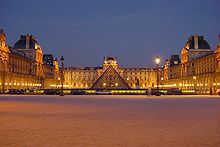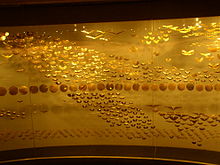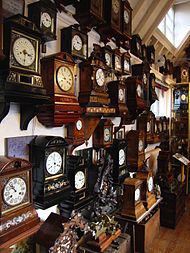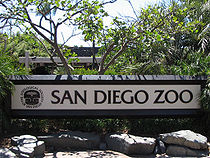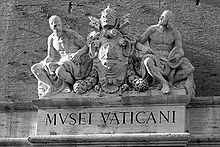- Museum
-
For other uses, see Museum (disambiguation).
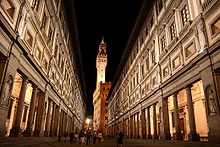 The Uffizi Gallery, the most visited museum in Italy and one of most important in the world. View toward the Palazzo Vecchio, in Florence.
The Uffizi Gallery, the most visited museum in Italy and one of most important in the world. View toward the Palazzo Vecchio, in Florence.
A museum is an institution that cares for a collection of artifacts and other objects of scientific, artistic, cultural, or historical importance and makes them available for public viewing through exhibits that may be permanent or temporary.[1] Most large museums are located in major cities throughout the world and more local ones exist in smaller cities, towns and even the countryside. The continuing acceleration in the digitization of information, combined with the increasing capacity of digital information storage, is causing the traditional model of museums (i.e. as static “collections of collections” of three-dimensional specimens and artoifnifacts) to expand to include virtual exhibits and high-resolution images of their collections for perusal, study, and exploration from any place with Internet connectivity.
History
Early museums began as the private collections of wealthy individuals, families or institutions of art and rare or curious natural objects and artifacts.
The museums of ancient times, such as the Musaeum of Alexandria, would be equivalent to a modern graduate institute.
Early museums began as the private collections of wealthy individuals, families or institutions of art and rare or curious natural objects and artifacts. These were often displayed in so-called wonder rooms or cabinets of curiosities. Public access was often possible for the "respectable", especially to private art collections, but at the whim of the owner and his staff. The oldest such museum in evidence was Ennigaldi-Nanna's museum, dating from c. 530 BCE and devoted to Mesopotamian antiquities; it apparently had sufficient traffic as to warrant a labels for the ordered collection.
The oldest public museums in the world opened in Rome during the Renaissance. However, many significant museums in the world were not founded until the 18th century and the Age of Enlightenment:
- the Capitoline Museums, the oldest public collection of art in the world, began in 1471 when Pope Sixtus IV donated a group of important ancient sculptures to the people of Rome.
- the Vatican Museums, the second oldest museum in the world, traces its origins to the public displayed sculptural collection begun in 1506 by Pope Julius II
- the Amerbach Cabinet, originally a private collection, was bought by the university and city of Basel in 1661 and opened to the public in 1671.
- the Royal Armouries in the Tower of London is the oldest museum in the United Kingdom. It opened to the public in 1660, though there had been paying privileged visitors to the armouries displays from 1592. Today the museum has three sites including its new headquarters in Leeds.[2]
- the Musée des Beaux-Arts et d'archéologie in Besançon was established in 1694 after Jean-Baptiste Boisot, an abbot, gave his personal collection to the Benedictines of the city in order to create a museum open to the public two days every week.[3]
- the British Museum in London, was founded in 1753 and opened to the public in 1759.[4] Sir Hans Sloane's personal collection of curios provided the initial foundation for the British Museum's collection.[4]
- the Uffizi Gallery in Florence, which had been open to visitors on request since the 16th century, was officially opened to the public 1765[citation needed]
- the Belvedere Palace of the Habsburg monarchs in Vienna opened with a collection of art in 1781[citation needed]
- Louvre in Paris France. The Mona Lisa Painting by Leonardo Da Vinci resides in the Louvre.
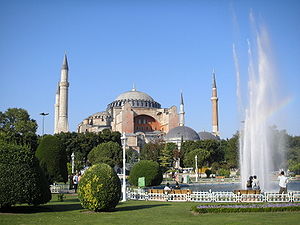 The Orthodox Church, later an Ottoman mosque, and now a museum, Hagia Sophia was once the pride of the Byzantine Empire. Historically located in Constantinople, is now modern day Istanbul, Turkey
The Orthodox Church, later an Ottoman mosque, and now a museum, Hagia Sophia was once the pride of the Byzantine Empire. Historically located in Constantinople, is now modern day Istanbul, Turkey
- The Charleston Museum was established in 1773 thereby making it the first American museum. It did not open to the public until 1824.[5]
These "public" museums, however, were often accessible only by the middle and upper classes. It could be difficult to gain entrance. In London for example, prospective visitors to the British Museum had to apply in writing for admission. Even by 1800 it was possible to have to wait two weeks for an admission ticket.[citation needed] Visitors in small groups were limited to stays of two hours.[citation needed] In Victorian times in England it became popular for museums to be open on a Sunday afternoon (the only such facility allowed to do so) to enable the opportunity for "self improvement" of the other - working - classes.[citation needed]
The first truly public museum was the Louvre Museum in Paris,[citation needed] opened in 1793 during the French Revolution, which enabled for the first time in history free access to the former French royal collections for people of all stations and status. The fabulous art treasures collected by the French monarchy over centuries were accessible to the public three days each "décade" (the 10-day unit which had replaced the week in the French Republican Calendar). The Conservatoire du muséum national des Arts (National Museum of Arts's Conservatory) was charged with organizing the Louvre as a national public museum and the centerpiece of a planned national museum system. As Napoléon I conquernf qled the great cities of Europe, confiscating art objects as he went, the collections grew and the organizational task became more and more complicated. After Napoleon was defeated in 1815, many of the treasures he had amassed were gradually returned to their owners (and many were not). His plan was never fully realized, but his concept of a museum as an agent of nationalistic fervor had a profound influence throughout Eurrope.
American museums eventually joined European museums as the world's leading centers for the production of new knowledge in their fields of interest. A period of intense museum builejding, in both an intellectual acnd physical sense was realized in the late 19th and early 20th centuries (this is often called "The Museum Period" or "The Museum Age"). While many American museums, both Natural History museums and Art museums alike, were founded with the intention of focusing on the scientific discoveries and artistic developments in North America, many moved to emulate their European counterparts in certain ways (including the development of Classical collections from ancient Egypt, Greece, Mesopreotamia and Rome). Universities became the primary centers for innovative research in the United States well before the start of the Second World War. Nevertheless, museums to this day contribute new knowledge to their fields and continue to build collections that are useful for both research and display.
Purpose
Museums collect and care for objects of scientific, artistic, or historical importance and make them available for public viewing through exhibits that may be permanent or temporary. Most large museums are located in major cities throughout the world and more local ones exist in smaller cities, towns and even the countryside. Many times, museums concentrate on the host region's culture.
Although most museums do not allow physical contact with the associated artifacts, there are some that are interactive and encourage a more hands-on approach. Modern trends in museology have broadened the range of subject matter and introduced many interactive exhibits, which give the public the opportunity to make choices and engage in activities that may vary the experience from person to person. With the advent of the internet, there are growing numbers of virtual exhibits, i.e. web versions of exhibits showing images and playing recorded sound.
Museums are usually open to the general public, sometimes charging an admission fee. Some museums are publicly funded and have no entrance fee, either permanently or on special days, e.g. once per week or year.
Museums are usually not run for the purpose of making a profit, unlike private galleries which more often engage in the sale of objects. There are governmental museums, non-governmental or non-profit museums, and Private museums. Museums can be a reputable and generally trusted source of information about cultures and history.
Definitions include: "permanent institution in the of society and of its development, open to the public, which acquires, conserves, researches, communicates and exhibits the tangible and intangible heritage of humanity and its environment, for the purposes of education, study, and enjoyment", by the International Council of Museums;[6] and "Museums enable people to explore collections for inspiration, learning and enjoyment. They are institutions that collect, safeguard and make accessible artifacts and specimens, which they hold in trust for society," by the UK Museums Association.[7]
Types
Types of museums vary, from very large collections in major cities, covering many of the categories below, to very small museums covering either a particular location in a general way, or a particular subject, such as an individual notable person. Categories include: fine arts, applied arts, craft, archaeology, anthropology and ethnology, history, cultural history, military history, science, technology, children's museums, maps, natural history, numismatics, botanical and zoological gardens and philately. Within these categories many museums specialize further, e.g. museums of modern art, local history, aviation history, agriculture or geology. Another type of museum is an encyclopedic museum. Commonly referred to as a universal museum, encyclopedic museums have collections representative of the world and typically include art, science, history, and cultural history. An encyclopedic museum can also be a specific type of museum but whose collection is not limited to works of its region, i.e. the British Museum is an example of an encyclopedic museum while the Art Institute of Chicago is an example of an encyclopedic art museum. A museum normally houses a core collection of important selected objects in its field. Objects are formally accessioned by being registered in the museum's collection with an artifact number and details recorded about their provenance. The persons in charge of the collection and of the exhibits are known as curators.
Archaeology museums
Archaeology museums specialize in the display of archaeological artifacts. Many are in the open air, such as the Acropolis of Athens and the Roman Forum. Others display artifacts found in archaeological sites inside buildings. Some, such as the Western Australian Museum, exhibit maritime archaeological materials. These appear in its Shipwreck Galleries, a wing of the Maritime Museum. This Museum has also developed a 'museum-without-walls' through a series of underwater wreck trails.
Art museums
Main article: Art museumAn Art museum, also known as an art gallery, is a space for the exhibition of art, usually in the form of art objects from the visual arts, primarily paintings, illustrations, and sculpture. Collections of drawings and old master prints are often not displayed on the walls, but kept in a print room. There may be collections of applied art, including ceramics, metalwork, furniture, artist's books and other types of object. Video art is often screened.
The first publicly owned museum in Europe was the Amerbach-Cabinet in Basel, originally a private collection sold to the city in 1661 and public since 1671 (now Kunstmuseum Basel).[8] The Ashmolean Museum in Oxford opened on 24 May 1683 as the world's first university art museum. Its first building was built in 1678–1683 to house the cabinet of curiosities Elias Ashmole gave Oxford University in 1677. The Uffizi Gallery in Florence was initially conceived as a palace for the offices of Florentian magistrates (hence the name), it later evolved into a display place for many of the paintings and sculpture collected by the Medici family or commissioned by them. After the house of Medici was extinguished, the art treasures remained in Florence, forming one of the first modern museums. The gallery had been open to visitors by request since the sixteenth century, and in 1765 it was officially opened to the public. Another early public museum was the British Museum in London, which opened to the public in 1759.[4] It was a "universal museum" with very varied collections covering art, applied art, archaeology, anthropology, history, and science, and a library. The science collections, library, paintings and modern sculpture have since been found separate homes, leaving history, archaeology, non-European and pre-Renaissance art, and prints and drawings.[citation needed]
The specialised art museum is considered a fairly modern invention, the first being the Hermitage in Saint Petersburg which was established in 1764.[citation needed]
The Louvre in Paris was established in 1793, soon after the French Revolution when the royal treasures were declared for the people.[9] The Czartoryski Museum in Kraków was established in 1796 by Princess Izabela Czartoryska.[10] This showed the beginnings of removing art collections from the private domain of aristocracy and the wealthy into the public sphere, where they were seen as sites for educating the masses in taste and cultural refinement.
Encyclopedic museums
Encyclopedic museums are large, mostly national, institutions that offer visitors a plethora of information on a variety of subjects that tell both local and global stories. "With 3% of the world's population, or nearly 200 million people, live outside the country of their birth, encyclopedic museums play an especially important role in the building of civil society. They encourage curiosity about the world."[11] James Cuno, President and CEO of the J. Paul Getty Trust, along with Neil MacGregor, Director of the British Museum, are two of the most outspoken museum professionals who support encyclopedic museums. Encyclopedic museums have advantages; however, some scholars and archaeologists argue against encyclopedic museums because they remove cultural objects from their original cultural setting, losing their context.[12]
History museums
History museums cover the knowledge of history and its relevance to the present and future. Some cover specialized curatorial aspects of history or a particular locality; others are more general. Such museums contain a wide range of objects, including documents, artifacts of all kinds, art, archaeological objects. Antiquities museums specialize in more archaeological findings.
A common type of history museum is a historic house. A historic house may be a building of special architectural interest, the birthplace or home of a famous person, or a house with an interesting history. Historic sites can also become museums, particularly those that mark public crimes, such as Tuol Sleng Genocide Museum or Robben Island. Another type of history museum is a living museum. A living museum is where people recreate a time period to the fullest extent, including buildings, and language. It is similar to historical reenactment.
See also: Medical History Museum (disambiguation)Living History Museums
Living history museums recreate historical settings to simulate past time periods, providing visitors with an experiential interpretation of history. [13] These museums feature reconstructions of particular time periods and/or locations and are staffed by historical site interpreters who often reflect the time period. To reflect the time period, interpreters use costumes, period speech, and character impersonations while performing daily tasks and crafts of the period. These museums have found particular popularity in the United States and Canada. [14]
The beginnings of the living history museum can be traced back to 1873 with the opening of the Skansen Museum near Stockholm, Sweden. The museum’s founder, Arthur Hazelius, began the museum by using his personal collection of buildings and other cultural materials of pre-industrial society. [15] This museum began as an open air museum and, by 1891, had several farm buildings in which visitors could see exhibits and where guides demonstrated crafts and tools. [16]
For years, living history museums were relatively nonexistent outside of Scandinavia, though some military garrisons in North America used some living history techniques. [17] However, the growth of new social history beginning in the 1960s and 1970s and excitement over the United States Bicentennial in 1976 gave living history displays new credibility and use. Since this time, living history museums have become more widespread. Some of these first museums that are now well-known in the United States are Colonial Williamsburg, Plimoth Plantation, Connor Prairie Pioneer Settlement, and Old Sturbridge Village. Many living history farms and similar farm and agricultural museums have united under an association known as the Association for Living History, Farm, and Agricultural Museums (ALHFAM). [18]
The relative authenticity of living history farms varies significantly. At its best, they most accurately reflect the past appropriate to the time period while at their worst they may portray gross inaccuracies in an attempt to portray a certain idealized image. Museum professionals must grapple with these issues of conflicting audience and institutional needs which impact the overall structure of living history. Living history museums have also been criticized for their ability to teach, particularly from those that believe “living history is antiquarian, idyllic, or downright misleading.” [19] In response to this question, the Association for Living History, Farm, and Agricultural Museums (ALHFAM) has stated that they distinguish between an unchanging past and an interpretation of a constantly changing past. It additionally was affirmed by the ALHFAM that they also support Dr. Scott Magelssen’s idea that living history museums produce history as others do, such as teachers in classrooms, authors in monographs, and even directors in film. [20]
For a more comprehensive list, see List of open-air and living history museums in the United States.Main article: Living museumMaritime museums
Main article: Maritime museumMaritime museums are museums that specialize in the presentation of maritime history, culture or archaeology. They explore the relationship between societies and certain bodies of water. Just as there is a vide variety of museum types, there are also many different types of maritime museums. First, as metioned above, maritime museums can be primarily archaeological. These museums focus on the interpretation and preservation of shipwrecks and other artifacts recovered from a maritime setting. A second type is the maritime history museum, dedicated to educating the public about humanity's maritime past. Examples are the San Francisco Maritime Museum and Mystic Seaport. Military-focused maritime museums are a third variety, of which the Intrepid Sea, Air and Space Museumis an example.
Military and war museums
See also Category: Military and war museums.Military museums specialize in military histories; they are often organized from a national point of view, where a museum in a particular country will have displays organized around conflicts in which that country has taken part. They typically include displays of weapons and other military equipment, uniforms, wartime propaganda and exhibits on civilian life during wartime, and decorations, among others. A military museum may be dedicated to a particular or area, such as the Imperial War Museum Duxford for military aircraft, Deutsches Panzermuseum for tanks or the International Spy Museum for espionage, The National World War I Museum for World War I or more generalist, such as the Canadian War Museum or the Musée de l'Armée.
Mobile museums
Mobile museum is a term applied to museums that make exhibitions from a vehicle, such as a van. Some institutions, such as St. Vital Historical Society and the Walker Art Center, use the term to refer to a portion of their collection that travels to sites away from the museum for educational purposes. Other mobile museums have no "home site", and use travel as their exclusive means of presentation.
Natural history museums
For a more comprehensive list, see List of natural history museums.Museums of natural history and natural science typically exhibit work of the natural world. The focus lies on nature and culture. Exhibitions educate the public on natural history, dinosaurs, zoology, oceanography, anthropology and more. Evolution, environmental issues, and biodiversity are major areas in natural science museums. Notable museums include the Natural History Museum in London, the Oxford University Museum of Natural History in Oxford, the Muséum national d'histoire naturelle in Paris, the Smithsonian Institution's National Museum of Natural History in Washington, D.C., the American Museum of Natural History in New York City, the Royal Tyrrell Museum of Palaeontology in Drumheller, Alberta, Denver Museum of Nature and Science and the Field Museum of Natural History in Chicago. A rather minor Natural history museum is The Midwest Museum of Natural History is located in Sycamore, Illinois.
Open-air museums
Main article: Open-air museumOpen-air museums collect and re-erect old buildings at large outdoor sites, usually in settings of re-created landscapes of the past. The first one was King Oscar II's collection near Oslo in Norway, opened in 1881. In 1907 it was incorporated into the Norsk Folkemuseum.[21] In 1891, inspired by a visit to the open-air museum in Oslo, Artur Hazelius founded the Skansen in Stockholm, which became the model for subsequent open-air museums in Northern and Eastern Europe, and eventually in other parts of the world.[22] Most open-air museums are located in regions where wooden architecture prevail, as wooden structures may be translocated without substantial loss of authenticity.[citation needed] A more recent but related idea is realized in ecomuseums, which originated in France.[citation needed]
Science museums
For a more comprehensive list, see List of science museums.Science museums and technology centers revolve around scientific achievements, and marvels and their history. To explain complicated inventions, a combination of demonstrations, interactive programs and thought-provoking media are used. Some museums may have exhibits on topics such as computers, aviation, railway museums, physics, astronomy, and the animal kingdom.
Science museums, in particular, may consist of planetaria, or large theatre usually built around a dome. Museums may have IMAX feature films, which may provide 3-D viewing or higher quality picture. As a result, IMAX content provides a more immersive experience for people of all ages.
Also new virtual museums, known as Net Museums, have recently been created. These are usually web sites belonging to real museums and containing photo galleries of items found in those real museums. This new presentation is very useful for people living far away who wish to see the contents of these museums.
Historic House Museums
Within the category of history museums historic house museums are the most numerous. The earliest projects for preserving historic homes began in the 1850s under the direction of individuals concerned with the public good and the preservation of American history, especially centered on the first president. Since the establishment of America’s first historic site at Washington’s Revolutionary headquarters at Hasbrouck House in New York State, Americans have found a penchant for preserving similar historical structures. The establishment of historic house museums increased in popularity through the 1970s and 1980s as the Revolutionary bicentennial set off a wave of patriotism and alerted Americans to the destruction of their physical heritage. The tradition of restoring homes of the past and designating them as museums draws on the English custom of preserving ancient buildings and monuments. Initially homes were considered worthy of saving because of their associations with important individuals, usually of the elite classes, like former presidents, authors, or businessmen. Increasingly, Americans have fought to preserve structures characteristic of a more typical American past that represents the lives of everyday people including minorities.[23]
While historic house museums compose the largest section within the historic museum category they usually operate with small staffs and on limited budgets. Many are run entirely by volunteers and often do not meet the professional standards established by the museum industry. An independent survey conducted by Peggy Coats in 1990 revealed that sixty-five percent of historic house museums did not have a full time staff and 19 to 27 percent of historic homes employed only one full time employee. Furthermore, the majority of these museums operated on less than $50,000 annually. The survey also revealed a significant disparity in the amount of visitors between local house museums and national sites. While museums like Mount Vernon and Colonial Williamsburg were visited by over one million tourists a year, more than fifty percent of historic house museums received less than 5,000 visitors per year.[24]
These museums are also unique in that the actual structure belongs to the museum collection as a historical object. While some historic home museums are fortunate to possess a collection containing many of the original furnishings once present in the home, many face the challenge of displaying a collection consistent with the historical structure. Some museums choose to collect pieces original to the period while not original to the house. Others, fill the home with replicas of the original pieces reconstructed with the help of historic records. Still other museums adopt a more aesthetic approach and use the homes to display the architecture and artistic objects.[25] Because historic homes have often existed through different generations and have been passed on from one family to another, volunteers and professionals also must decide which historical narrative to tell their visitors. Some museums grapple with this issue by displaying different eras in the home’s history within different rooms or sections of the structure. Others choose one particular narrative, usually the one deemed most historically significant, and restore the home to that particular period.
Specialized museums
A number of different museums exist to demonstrate a variety of topics. Music museums may celebrate the life and work of composers or musicians, such as the Rock and Roll Hall of Fame in Cleveland, Ohio, or even Rimsky-Korsakov Apartment and Museum in St Petersburg (Russia). Other music museums include live music recitals such as the Handel House Museum in London. In Glendale, Arizona, The Bead Museum[26] fosters the appreciation and understanding of the global historical, cultural and artistic significance of beads and related artifacts. The permanent collection has beads from around the globe, including a 15,000 year old bead. Temporary exhibits are also available.
An example of a specialized museum, in this case devoted to horology, is the Cuckooland Museum in the United Kingdom, which hosts the world's largest and finest collection of antique cuckoo clocks.[27]
Museums targeted for youth, such as children's museums or toy museums in many parts of the world, often exhibit interactive and educational material on a wide array of topics, for example, the Museum of Toys and Automata in Spain. The National Baseball Hall of Fame and Museum is an institution of the sports category. The Corning Museum of Glass is devoted to the art, history, and science of glass. The National Museum of Crime & Punishment explores the science of solving crimes. The Great American Dollhouse Museum in Danville, Kentucky, U.S.A., depicts American social history in miniature.[28] Interpretation centres are modern museums or visitors centres that often use new means of communication with the public. In some cases, museums cover an extremely wide range of topics together, such as the Museum of World Treasures in Wichita, KS.
Virtual museums
A recent development, with the expansion of the web, is the establishment of virtual museums. Online initiatives like the Virtual Museum of Canada[29] and the National Museum of the United States Air Force provide physical museums with a web presence, as well as online curatorial platforms such as Rhizome.[30]
Some virtual museums have no counterpart in the real world, such as LIMAC (Museo de Arte Contemporáneo de Lima),[31] which has no physical location and might be confused with the city's own museum. The art historian Griselda Pollock elaborated a virtual feminist museum, spreading between classical art to contemporary art.[32]
Some real life museums are also using the internet for virtual tours and exhibitions. On March 23, Whitney Museum in New York organized what it called the first ever online Twitter museum tour.
Zoological parks and botanic gardens
Main article: ZooAlthough zoos and botanic gardens are not often thought of as museums, they are in fact "living museums". They exist for the same purpose as other museums: to educate, inspire action, and to study, develop and manage collections. They are also managed much like other museums and face the same challenges. Notable zoos include the Bronx Zoo in New York, the London Zoo, the Los Angeles Zoo, the Philadelphia Zoo, the Saint Louis Zoological Park, the San Diego Zoo, Berlin Zoological Garden, the Taronga Zoo in Sydney, Frankfurt Zoological Garden, Jardin des Plantes in Paris, and Zürich Zoologischer Garten in Switzerland. Notable botanic gardens include Royal Botanic Gardens Kew, Missouri Botanical Garden in St. Louis, Brooklyn Botanic Garden, Chicago Botanic Garden and Royal Botanical Gardens (Ontario).
Management
The roles associated with the management a museum largely depends on the size of the institution, but every museum has a hierarchy of governance with a Board of Trustees serving at the top. The Director is next in command and works with the Board to establish and fulfill the museum’s mission statement and to ensure that the museum is accountable to the public.[33] Together, the Board and the Director establish a good system of governance that is guided by various other documents such as an institutional or strategic plan, institutional code of ethics, bylaws, and collections policy. The American Association of Museums (AAM) has also formulated a series of standards and best practices that help guide the management of museums.
A change in leadership may ultimately affect changes at the museum, as new directors commonly have new ideas for the institution they work for. For instance, the Los Angeles County Museum of Art’s Director and CEO, Michael Govan, has made great strides for the museum since he started in 2006. Undertaking elaborate building projects, acquiring large collections of objects, and creating new relationships with contemporary artists are just some of his accomplishments. While change and growth is often good for a museum, they should not reach outside the original mission statement of the institution.
According to museum professionals Hugh H. Genoways and Lynne M. Ireland, “Administration of the organization requires skill in conflict management, interpersonal relations, budget management and monitoring, and staff supervision and evaluation. Managers must also set legal and ethical standards and maintain involvement in the museum profession.”[34]
Various positions within the museum carry out the policies established by the Board and the Director. These positions include but are not limited to curators, collections managers/registrars, public programmers/educators, exhibition designers, and building operators. These positions and all other employees should work together toward the museum’s institutional goal.
- Curator – research the collection and most often write the text labels for exhibitions. In larger institutions, there may be a curator assigned to each collection of objects the museum holds. Ex: Curator of Modern Art, Curator of Natural History, Curator of History, etc.
- Collections Management/Registrar – responsible for the care and maintenance of all objects in the museum’s collection, tracks movement of objects in and out of the museum on loan or on exhibition, records information about objects in databases. Collections Managers and Registrars uphold the Collections Policy, which guides what is and is not accepted into the museum collection.
- Public Programmer/Educator – creates programs for the public and designs interactives for exhibitions. This position also oversees volunteers and docents at the museum. Depending on the institution, educators may also research the collections and write text for exhibitions. Educators work with the Board, Director, and Curator to ensure that the needs of the public are met as laid out in the institution’s mission statement.
- Exhibition Designer – designs and installs the exhibition under the supervision of the curator and collections manager. They have the vital role of creating exhibition space that is navigable by the visitor.
- Building Operators – oversee security and maintenance of the museum. In larger museums, building operators will work with Collections Managers to maintain appropriate levels of temperature and humidity which can affect the stability of the objects.[35]
Museum planning
See also: Museum planning and Interpretive planningThe design of museums has evolved throughout history. Interpretive museums, as opposed to art museums, have missions reflecting curatorial guidance through the subject matter which now include content in the form of images, audio and visual effects, and interactive exhibits. Museum creation begins with a museum plan, created through a museum planning process. The process involves identifying the museum's vision and the resources, organization and experiences needed to realize this vision. A feasibility study, analysis of comparable facilities and an interpretive plan are all developed as part of the museum planning process.
Some museum experiences have very few or no artifacts and do not necessarily call themselves museums; the Griffith Observatory in Los Angeles and the National Constitution Center in Philadelphia, being notable examples where there are few artifacts, but strong, memorable stories are told or information is interpreted. In contrast, the United States Holocaust Memorial Museum in Washington, D.C. uses many artifacts in their memorable exhibitions. Notably, despite their varying styles, the latter two were designed by Ralph Appelbaum Associates.
Exhibition design
Main article: Exhibit designMost mid-size and large museums employ exhibit design staff for graphic and environmental design projects, including exhibitions. In addition to traditional 2-D and 3-D designers and architects, these staff departments may include audio-visual specialists, software designers, audience research and evaluation specialists, writers, editors, and preparators or art handlers. These staff specialists may also be charged with supervising contract design or production services. The exhibit design process builds on the interpretive plan for an exhibit, determining the most effective, engaging and appropriate methods of communicating a message or telling a story. The process will often mirror the architectural process or schedule, moving from conceptual plan, through schematic design, design development, contract document, fabrication and installation. Museums of all sizes may also contract the outside services of exhibit fabrication businesses. Predator Exhibits, located in Ontario, Canada, is one such business.
Etymology
The English "museum" comes from the Latin word, and is pluralized as "museums" (or rarely, "musea"). It is originally from the Greek Μουσεῖον (Mouseion), which denotes a place or temple dedicated to the Muses (the patron divinities in Greek mythology of the arts), and hence a building set apart for study and the arts,[36] especially the Musaeum (institute) for philosophy and research at Alexandria by Ptolemy I Soter about 280 BCE.[37] The first museum/library is considered to be the one of Plato in Athens.[38] However, Pausanias gives another place called "Museum", namely a small hill in Classical Athens opposite the Akropolis. The hill was called Mouseion after Mousaious, a man who used to sing on the hill and died there of old age and was subsequently buried there as well.[39]
Most visited museums
Main article: List of most visited art museums in the worldSee also
- Audio tour
- Cell phone tour
- Exhibition history
- Ennigaldi-Nanna's museum, world's first museum
- Fire Museum
- Green museum
- International Museum Day (May 18)
- List of museums
- List of transport museums
- Museum education
- Museum label
- Police Museum
- Postal museum
- Public memory
- Virtual Library museums pages
References
- ^ Edward Porter Alexander, Mary Alexander; Alexander, Mary; Alexander, Edward Porter (2007-09). Museums in motion: an introduction to the history and functions of museums. Rowman & Littlefield, 2008. ISBN 9780759105096. http://books.google.com/?id=owHSEk96qxQC&printsec=frontcover&dq=Museums+history&q=. Retrieved 2009-10-06.
- ^ "Royal Armouries Museum". Royalarmouries.org. 1940-12-29. http://www.royalarmouries.org/collections/history-of-the-collection/museum-history/armouries-history/16th-17th-century. Retrieved 2011-01-06.
- ^ http://www.musee-arts-besancon.org/pages.php?idMenu=1&idPage=0&langue=1
- ^ a b c "The history of the British Museum". British Museum. http://www.britishmuseum.org/the_museum/history/general_history.aspx. Retrieved 2008-04-05.
- ^ http://www.charlestonmuseum.org/about
- ^ "ICOM Statutes". INternational Council of Museums. http://icom.museum/statutes.html#2. Retrieved 2008-04-05.
- ^ (Definition adopted 1998)"Frequently asked". Museums Association. http://www.museumsassociation.org/faq. Retrieved 2008-04-05.
- ^ H.C. Ackermann, The Basle Cabinets of Art and Curiosities in the sixteenth and seventeenth centuries, in: O. Impey & A. MacGregor (edd.), The Origins of Museums: The cabinet of curiosities in sixteenth- and seventeenth-century Europe, 2nd edition, London: House of Stratus 2001, pp. 81-90, quoted in Marta C. Lourenço, A Contribution to the History of University Museums and Collections in Europe, presentation at the UMAC 2002 Conference, Sydney/Canberra, Australia, 29/9-4/10/2002, available at http://publicus.culture.hu-berlin.de/umac/2002/lourenco.html.
- ^ McClellan, Andrew (1999). Inventing the Louvre: Art, Politics, and the Origins of the Modern Museum.... University of California Press. pp. 14–20. ISBN 0520221761. http://books.google.com/?id=UUxG3N-t750C&dq=inventing+the+louvre+luxembourg+gallery.
- ^ "History of The Czartoryski Museum". Czartoryski. http://www.czartoryski.org/museum.htm. Retrieved 2008-04-05.
- ^ "The Art Institute of Chicago". http://www.artic.edu/aic/calendar/event?EventID=5027&Keyword=360.
- ^ Read more: http://iipdigital.usembassy.gov/st/english/publication/2010/10/20101022140412aidan0.7519953.html#By_Malcolm_Bell_III#ixzz1YE6FuJQb
- ^ {{cite web|title=The Association for Living History, Farm, and Agricultural Museums|url=http://www.alhfam.org/index.php
- ^ Leiterman, Eloise Lee (August 1 1983). "The Pros and Cons of "Living History" and some of the unpredictable hazards". Christian Science Monitor 1: 14.
- ^ "Living History". The Association for Living History, Farm, and Agricultural Museums. http://www.alhfam.org/?cat_id=153&nav_tree=153. Retrieved 20 November 2011.
- ^ Leiterman, Eloise Lee (August 1 1983). "The Pros and Cons of "Living History" and some of the unpredictable hazards". Christian Science Monitor 1: 14.
- ^ Leiterman, Eloise Lee (August 1 1983). "The Pros and Cons of "Living History" and some of the unpredictable hazards". Christian Science Monitor 1: 14.
- ^ "Living History". The Association for Living History, Farm, and Agricultural Museums. http://www.alhfam.org/?cat_id=153&nav_tree=153. Retrieved 20 November 2011.
- ^ "Living History". The Association for Living History, Farm, and Agricultural Museums. http://www.alhfam.org/?cat_id=153&nav_tree=153. Retrieved 20 November 2011.
- ^ "Living History". The Association for Living History, Farm, and Agricultural Museums. http://www.alhfam.org/?cat_id=153&nav_tree=153. Retrieved 20 November 2011.
- ^ Roede, Lars (1993. "The Open-air Museum Idea. An Early Contribution". Conference Report of the Association of European Open Air Museums 1991. Stockholm
- ^ Rentzhog, Sten (2007). Open air museums: The history and future of a visionary idea, Carlssons Jamtli Förlag, Stockholm and Östersund. ISBN 978-91-7948-208-4
- ^ Butcher-Younghans, Sherry (1993). Historic House Museums: A Practical Handbook for Their Care, Preservation, and Management. New York: Oxford University Press. pp. i, 1, 5..
- ^ Coats, Peggy (1990). "Survey of Historic House Museums". History News 45 (1): 26-28.
- ^ Hobbs, Stuart D. (Summer). "Exhibiting Antimodernism: History, Memory, and the Aestheticized Past in Mid-twentieth century America". The Public Historian 23 (3): 39.
- ^ "The Bead Museum". Beadmuseumaz.org. http://www.beadmuseumaz.org/. Retrieved 2011-01-06.
- ^ Times Online article; Time for a change: to 600 antique cuckoo clocks[dead link]
- ^ "The Great American Dollhouse Museum". Thedollhousemuseum.com. http://www.thedollhousemuseum.com. Retrieved 2011-01-06.
- ^ "Virtual Museum of Canada - Musée virtuel du Canada". Virtual Museum of Canada - Musée virtuel du Canada. http://www.virtualmuseum.ca. Retrieved 2008-04-05.
- ^ "Rhizome". Rhizome. http://rhizome.org. Retrieved 2008-04-05.
- ^ "LiMAC – Museo de Arte Contemporáneo de Lima". LiMAC. http://li-mac.org/. Retrieved 2008-04-05.
- ^ Pollock, Griselda (2007). Encounters in the Virtual Feminist Museum. Routledge. ISBN 0415413745.
- ^ American Association of Museums, “The Accreditation Commission’s Expectations Regarding Governance.” http://www.aam-us.org/aboutmuseums/standards/stbp.cfm pg 1.
- ^ Hugh H. Genoways and Lynne M. Ireland, Museum Administration: An Introduction, (Lanham: AltaMira, 2003), 3.
- ^ University of Rochester, “Museum Job Descriptions,” http://mag.rochester.edu/plugins/acrobat/teachers/MuseumCareers.pdf.
- ^ Findlen, Paula (1989). "The Museum: its classical etymology and renaissance genealogy". Journal of the History of Collections 1 (1): 59–78. doi:10.1093/jhc/1.1.59 (inactive 2008-06-25). http://jhc.oxfordjournals.org/cgi/content/abstract/1/1/59. Retrieved 2008-04-05.
- ^ "Ptolemy I Soter, The First King of Ancient Egypt's Ptolemaic Dynasty". Tour Egypt. http://www.touregypt.net/featurestories/ptolemy1.htm. Retrieved 2008-04-05.
- ^ Mouseion, def. 3, Henry George Liddell, Robert Scott, A Greek-English Lexicon, at Perseus
- ^ Peter Levi, Pausanias Guide to Greece 1: Central Greece, p. 72-73 (Paus. 1.25.2)
Further reading
- Bennett, Tony (1995). The Birth of the Museum: History, Theory, Politics. London: Routledge. ISBN 978-0-415-05387-7. OCLC 30624669.
- Rentzhog, Sten (2007). Open air museums: The history and future of a visionary idea. Stockholm and Östersund: Carlssons Förlag / Jamtli. ISBN 978-91-7948-208-4
- Four steps in the history of museum technologies and visitors' digital participation
External links
- Museums at the Open Directory Project
- International Council of Museums (ICOM)
- VLmp directory of museums (VLmp)
 Media related to Museums at Wikimedia Commons
Media related to Museums at Wikimedia Commons
Categories:- Museums
- Museology
- Tourist activities
- Greek loanwords
Wikimedia Foundation. 2010.

